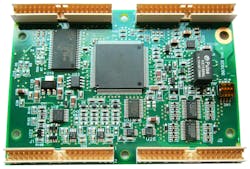11 Myths About Chassis Management in SOSA-Aligned Systems
What you’ll learn:
- How chassis management facilitates interoperability.
- The types of system data and functions monitored.
- What keeps SOSA-aligned systems healthy.
Based on the ANSI/VITA 46.11-2022 standard “System Management on VPX,” the SOSA Chassis Manager interfaces to and controls resources in the chassis to provide real-time, remote monitoring of system hardware. It plays a key role in keeping a system healthy, so understanding how SOSA-aligned systems will implement chassis management across platforms is crucial, as we’re on the brink of deploying systems based on this mandated open standard.
Here we clarify some of the misunderstandings commonly associated with implementing a Chassis Manager within a SOSA-aligned system.
1. The SOSA standard has no bearing on chassis management.
First and foremost, it’s important to understand that chassis management is a key component of the SOSA system-management module infrastructure. Much of the SOSA infrastructure relies directly on VITA 46.11-based chassis management for its core functionality, as it gives system engineers a tool that monitors overall health. It also identifies anomalies and takes corrective action in systems developed to meet today’s interoperability initiatives as put forth by the U.S. Department of Defense (DoD) (Fig. 1).
2. SOSA has a custom chassis-management definition.
Next, and equally as important, SOSA does not define a custom chassis-management architecture. Rather, it clarifies a particular architectural approach to implementing chassis management within the VPX standard, specifically leveraging the VITA 46.11 system-management definitions.
VITA 46.11 is a large document with many options. SOSA defines which options are mandatory for plug-in cards (PICs), Intelligent Platform Management Controllers (IPMCs), and Chassis Manager hardware. For features that can be used in multiple ways, it constrains how SOSA systems will use them. All of this is done with an eye on SOSA principles, such as interoperability, replaceability, and ease of integration.
3. Plug-in cards aren’t required by the SOSA standard to support out-of-band chassis management.
The SOSA Technical Standard requires that any SOSA conformant PIC contains a SOSA conformant IPMC. The IPMC is the entity on the PIC that the Chassis Manager interacts with to monitor and control the PIC. The SOSA document is very clear about what functionality the required IPMC must support.
4. Every SOSA-aligned Chassis Manager has a different user interface.
Prior to SOSA, each vendor had a different user interface to query and control their VITA 46.11 Chassis Managers. However, SOSA has defined a RESTful interface as a part of the SOSA in-band system management for providing this user interface. As a result, any SOSA-aligned system manager module should have no difficulty communicating with, and controlling, any SOSA-aligned Chassis Manager hardware card (Fig. 2).
5. VITA 46.11 Tier-1 functionality is good enough for a SOSA Chassis Manager card.
SOSA was very all-encompassing when it defined which VITA 46.11 functions that should be supported by a Chassis Manager or PIC IPMC. It defines an extensive list of mandatory commands that include Tier-1, Tier-2, and Tier-3, and that more commands be supported by both PIC IPMCs and Chassis Manager hardware in order to be SOSA-aligned.
6. Chassis management is a waste of a valuable slot in my system.
While a Chassis Manager could be implemented as a PIC that would take up a slot in the system, it doesn’t have to be the case. It can be implemented on a PIC that performs other functions, or it can be a standalone card that’s connected to the backplane by cables, or even a mezzanine on the backplane. SOSA is silent as to how the Chassis Manager is implemented, as long as the interfaces and functionality are conformant to the standard.
7. A SOSA Chassis Manager’s only connection to a plug-in card is through the IPMB.
A Chassis Manager has two basic connectivity paths defined within SOSA—one through the Intelligent Platform Management Bus (IPMB) and another through Ethernet, typically connecting to the Control Plane. This Ethernet connection is critical because SOSA in-band commands and communications between the Chassis Manager and the System Manager Module, which may be running on a PIC, must pass through this channel.
8. SOSA chassis management is only good for measuring temperatures and controlling fans.
While it’s true that temperature measurements—both on the PICs and inside the chassis—and fan control are important parts of SOSA chassis management, the Chassis Manager provides much more. This includes monitoring the quality of the power rails and command changes among the power supplies. Therefore, if problems arise, it can control the order in which PICs are powered on and booted.
It can also monitor and report on the state of individual PICs and the applications running on them, as well as detect, report, and sometimes even correct faults in hardware. It can even perform FRU inventory, FRU recovery, and diagnostic management. There’s a host of functionality provided by SOSA chassis management.
9. SOSA chassis management is a single point of failure in systems.
SOSA makes it possible to include redundant Chassis Managers as well as separate IPMBs. Therefore, in the event of a Chassis Manager failure or a PIC failing in such a way as to block an IPMB, a secondary Chassis Manager or IPMB is available to keep the system going, and perhaps even recover from the fault.
10. Chassis management is a security hole.
Certainly out-of-band chassis management potentially could provide attack vectors that may compromise the security of a system. However, VITA 46.11 provides features such as the bridged firewall functions to manage communication between the various IPMI channels implemented by a device. For instance, it can allow or disallow a given message to be bridged to a specified channel using the “Send Message” command.
SOSA is also taking additional steps to address security issues. So, if chassis management is implemented correctly on both the chassis-management card and the PICs, most, if not all, security concerns will be addressed.
11. Chassis management is an expensive, nice-to-have feature that doesn’t provide any real value to my system.
Not only is SOSA-aligned chassis management provided by a chassis-management controller card that’s often reasonably affordable, but the card usually draws very little power (maybe in the 1- to 3-W range) as well. As far as value goes, chassis management can provide extremely insightful data about the state of your system, and when used correctly, can have a huge impact on the reliability and longevity of your system. The potential benefits are, truly, too numerous to count.
About the Author

Mark Littlefield
Sr. Manager, Embedded Computing Solutions, Elma Electronic
Mark Littlefield is senior manager of embedded computing products and services for Elma Electronic. He’s an active contributor to multiple VITA and SOSA technical working groups, leads the SOSA small-form-factor (SFF) sub-committee, and was co-chair of the VITA 65 OpenVPX working group.
Mark has more than 25 years of experience in embedded computing, where he has held a range of technical and professional roles supporting defense, medical, and commercial applications. He holds bachelor's and master’s degrees in control systems engineering from the University of West Florida, where he wrote his thesis on a neural-net approach to image processing.


